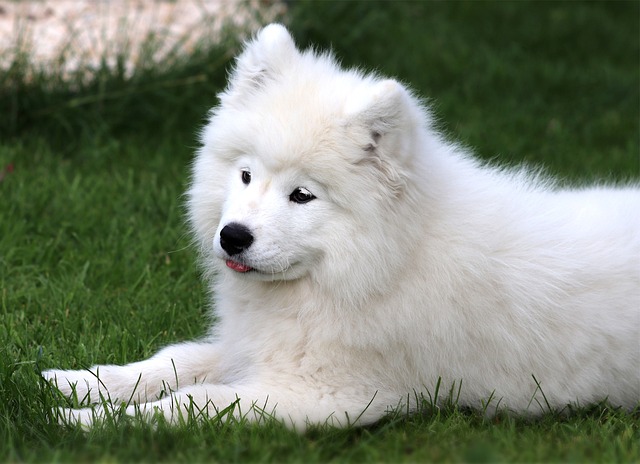
What is glaucoma in a dog?
You might notice your dog squinting more at mealtime or avoiding bright sunlight—these small changes could be early signs of a serious eye condition.
The Samoyed, with its snow - white fur and cute appearance, is deeply loved by everyone. However, in hot weather, they are highly vulnerable to the threat of heatstroke. Heatstroke is a rather dangerous situation for Samoyeds, and we need to respond promptly. Moreover, it is crucial to take preventive measures in advance so that our Samoyeds can live a healthy and happy life even in summer.
What to Do if a Samoyed Gets Heatstroke
The treatment methods for a Samoyed with heatstroke are as follows:
1.When you notice that a Samoyed is panting heavily and shows signs of heatstroke, immediately provide it with a large amount of water to drink, and turn on the air - conditioner and electric fan to help it cool down.
2.Once a Samoyed shows heatstroke symptoms, the owner should take immediate self - rescue measures instead of just waiting for the veterinarian to come and treat the Samoyed.
3.When you find that the Samoyed can't stand up, immediately perform bloodletting on it to lower the blood pressure. Use a knife to make a cut at the base of the Samoyed's tail to let it bleed. As soon as the Samoyed's condition stabilizes slightly, send it to the hospital for treatment immediately. Remember to find a car with an air - conditioner!
4.If the Samoyed's heatstroke symptoms are relatively severe, immediately rinse its whole body with cold water (not ice water) to cool it down. If possible, place the Samoyed in a cold - water bathtub to help it cool down.

How to Prevent a Samoyed from Getting Heatstroke
1.Provide Sufficient Cool Water for the Dog
In high - temperature summers, dogs don't sweat well and need to drink a large amount of water to maintain water balance, especially long - haired dogs like Samoyeds. Always provide your dog with sufficient cool drinking water to avoid dehydration.
2.Avoid Direct Sunlight at Noon
The sun is intense at noon, and dogs are prone to heatstroke. To protect the health of the Samoyed, it is best to place its kennel in a well - ventilated area indoors and avoid direct sunlight at noon.
3.Trim the Dog's Hair
Samoyeds have thick fur. When summer comes, their hair should be trimmed to help with heat dissipation. However, after trimming, pay attention to providing shade to prevent sunburn on the skin.
4.Maintain Good Ventilation
Summer is hot, and good indoor ventilation should be maintained. Samoyeds are best kept in an environment with good ventilation and no direct sunlight, keeping the air in the room circulating.
5.Avoid Excessive Exercise Intensity
In high - temperature summer weather, excessive exercise intensity can easily cause Samoyeds to get heatstroke and damage their bodies. Appropriately control the dog's exercise volume and avoid strenuous activities during hot periods.
6.Keep the Living Environment Dry
The fur of Samoyeds can easily accumulate water and is difficult to dry, making it prone to sunburn from ultraviolet rays. Therefore, regularly wipe and dry the dog to keep its fur clean and dry.
In conclusion, heatstroke in Samoyeds is a problem that requires our high attention. Once heatstroke signs are detected, we should quickly and correctly take first - aid measures such as providing water, cooling, and bloodletting (in critical situations), and send the dog to the hospital in a timely manner. In the daily breeding process, preventive measures such as providing sufficient water, avoiding direct sunlight, appropriate hair - trimming, maintaining ventilation, controlling exercise volume, and keeping the living environment dry can effectively reduce the risk of Samoyed heatstroke. As Samoyed owners, it is our responsibility to create a comfortable and safe living environment for them so that they can spend every season healthily.

You might notice your dog squinting more at mealtime or avoiding bright sunlight—these small changes could be early signs of a serious eye condition.

Let’s set the scene: It’s a sweltering Phoenix afternoon—105°F outside—and you rushed your 2-year-old Lab mix, Cooper, on a quick walk to “get it over with.”

Let’s get real: You’re in your Miami apartment, watching your 3-year-old Corgi, Loki, struggle to climb the stairs to your second-floor unit.

Many dog owners brush off occasional scratching as just “dog behavior,” but persistent itching often signals something more—like a food allergy.

You might first notice your dog scratching more than usual—chewing at their paws until the fur looks thin, or rubbing their face against the couch nonstop.

Let’s be real: You’re standing in your Chicago apartment, watching your 3-year-old Beagle, Max, huff and puff just to climb onto the couch.